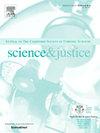The microbiome and volatile organic compounds reflecting the state of decomposition in an indoor environment
IF 1.9
4区 医学
Q2 MEDICINE, LEGAL
引用次数: 0
Abstract
Given that a variety of factors can affect the decomposition process, it can be difficult to determine the post-mortem interval (PMI). The process is highly dependent on microbial activity, and volatile organic compounds (VOCs) are a by-product of this activity. Given both have been proposed to assist in PMI determination, a deeper understanding of this relationship is needed. The current study investigates the temporal evolution of the microbiome and VOC profile of a decomposing human analog (swine) in a controlled, indoor environment. Microbial communities were sampled at six-time points up to the active decay phase (72 swabs in total). VOC headspace samples were collected every six hours with six sampling times in common with the swab times. Sampling locations included the abdominal area, anus, right ear canal, and right nostril. Bacterial communities were found to significantly change during decomposition (p < 0.001), and communities shifted differently based on sample location. The families Moraxellaceae, Planococcaceae, Lactobacillaceae, and Staphylococcaceae drove these community shifts. From random forest analysis, the nostril sampling location was determined to be the best location to predict stage of decomposition. Individual VOCs exhibited large temporal shifts through decomposition stage in contrast to smaller shifts when evaluated based on functional groups. Finally, pairwise linear regression models between abdominal area bacteria and selected VOCs were assessed; Planococcaceae and Tissierellaceae were significantly correlated to indole. Overall, this study provides an exploratory analysis to support the connection between the microbiome, VOCs, and their relationship throughout decomposition.
反映室内环境中分解状态的微生物组和挥发性有机化合物
由于多种因素会影响分解过程,因此很难确定死亡后的时间间隔(PMI)。该过程高度依赖于微生物活动,而挥发性有机化合物(VOCs)是这种活动的副产品。考虑到这两种方法都是用来帮助确定PMI的,因此需要更深入地了解这种关系。目前的研究调查了在受控的室内环境中分解人类类似物(猪)的微生物组和VOC谱的时间演变。微生物群落在六个时间点采样,直到活跃的衰变阶段(总共72个拭子)。每6小时收集一次VOC顶空样品,采样次数与拭子取样次数相同。取样部位包括腹部、肛门、右耳道和右鼻孔。细菌群落在分解过程中发生了显著变化(p <;0.001),并且社区根据样本位置发生了不同的变化。Moraxellaceae, Planococcaceae, Lactobacillaceae和Staphylococcaceae推动了这些群落的变化。通过随机森林分析,确定了鼻孔采样位置是预测分解阶段的最佳位置。在分解阶段,单个VOCs表现出较大的时间变化,而基于官能团的评估则表现出较小的时间变化。最后,对腹部细菌与选定挥发性有机化合物之间的两两线性回归模型进行评估;Planococcaceae和Tissierellaceae与吲哚呈极显著相关。总的来说,本研究提供了一项探索性分析,以支持微生物组、挥发性有机化合物之间的联系,以及它们在分解过程中的关系。
本文章由计算机程序翻译,如有差异,请以英文原文为准。
求助全文
约1分钟内获得全文
求助全文
来源期刊

Science & Justice
医学-病理学
CiteScore
4.20
自引率
15.80%
发文量
98
审稿时长
81 days
期刊介绍:
Science & Justice provides a forum to promote communication and publication of original articles, reviews and correspondence on subjects that spark debates within the Forensic Science Community and the criminal justice sector. The journal provides a medium whereby all aspects of applying science to legal proceedings can be debated and progressed. Science & Justice is published six times a year, and will be of interest primarily to practising forensic scientists and their colleagues in related fields. It is chiefly concerned with the publication of formal scientific papers, in keeping with its international learned status, but will not accept any article describing experimentation on animals which does not meet strict ethical standards.
Promote communication and informed debate within the Forensic Science Community and the criminal justice sector.
To promote the publication of learned and original research findings from all areas of the forensic sciences and by so doing to advance the profession.
To promote the publication of case based material by way of case reviews.
To promote the publication of conference proceedings which are of interest to the forensic science community.
To provide a medium whereby all aspects of applying science to legal proceedings can be debated and progressed.
To appeal to all those with an interest in the forensic sciences.
 求助内容:
求助内容: 应助结果提醒方式:
应助结果提醒方式:


